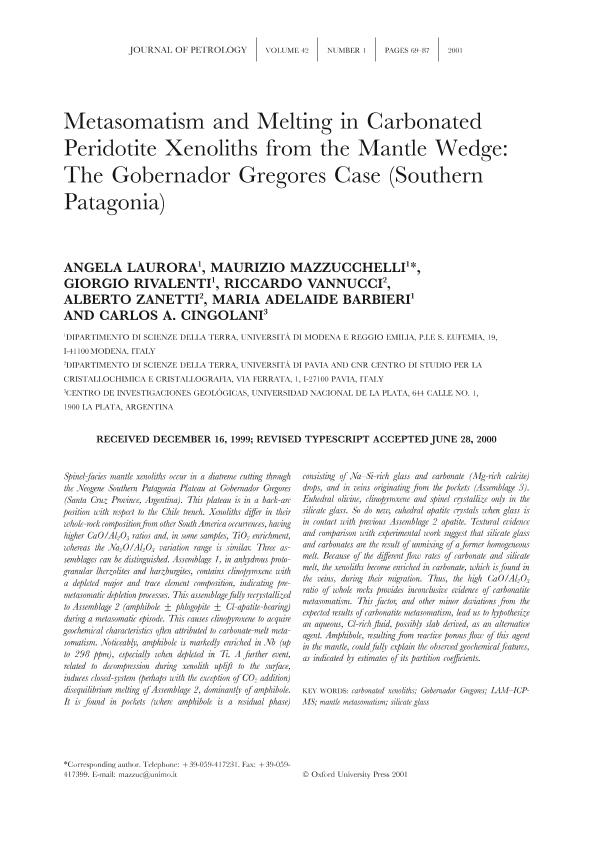Artículo
Metasomatism and Melting in Carbonated Peridotite Xenoliths from the Mantle Wedge: The Gobernador Gregores Case (Southern Patagonia)
Laurora, Angela; Mazzucchelli, Maurizio; Rivalenti, Giorgio; Vannucci, Riccardo; Zanetti, Alberto; Barbieri, María Adelaide; Cingolani, Carlos Alberto

Fecha de publicación:
01/2001
Editorial:
Oxford University Press
Revista:
Journal of Petrology
ISSN:
0022-3530
e-ISSN:
1460-2415
Idioma:
Inglés
Tipo de recurso:
Artículo publicado
Clasificación temática:
Resumen
Spinel-facies mantle xenoliths occur in a diatreme cutting through the Neogene Southern Patagonia Plateau at Gobernador Gregores (Santa Cruz Province, Argentina). This plateau is in a back-arc position with respect to the Chile trench. Xenoliths differ in their whole-rock composition from other South America occurrences, having higher CaO/Al2O3 ratios and, in some samples, TiO2 enrichment, whereas the Na2O/Al2O3 variation range is similar. Three assemblages can be distinguished. Assemblage 1, in anhydrous protogranular lherzolites and harzburgites, contains clinopyroxene with a depleted major and trace element composition, indicating pre-metasomatic depletion processes. This assemblage fully recrystallized to Assemblage 2 (amphibole ± phlogopite ± Cl-apatite-bearing) during a metasomatic episode. This causes clinopyroxene to acquire geochemical characteristics often attributed to carbonate-melt metasomatism. Noticeably, amphibole is markedly enriched in Nb (up to 298 ppm), especially when depleted in Ti. A further event, related to decompression during xenolith uplift to the surface, induces closed-system (perhaps with the exception of CO2 addition) disequilibrium melting of Assemblage 2, dominantly of amphibole. It is found in pockets (where amphibole is a residual phase) consisting of Na–Si-rich glass and carbonate (Mg-rich calcite) drops, and in veins originating from the pockets (Assemblage 3). Euhedral olivine, clinopyroxene and spinel crystallize only in the silicate glass. So do new, euhedral apatite crystals when glass is in contact with previous Assemblage 2 apatite. Textural evidence and comparison with experimental work suggest that silicate glass and carbonates are the result of unmixing of a former homogeneous melt. Because of the different flow rates of carbonate and silicate melt, the xenoliths become enriched in carbonate, which is found in the veins during their migration. Thus, the high CaO/Al2O3 ratio of whole rocks provides inconclusive evidence of carbonatite metasomatism. This factor, and other minor deviations from the expected results of carbonatite metasomatism, lead us to hypothesize an aqueous, Cl-rich fluid, possibly slab derived, as an alternative agent. Amphibole, resulting from reactive porous flow of this agent in the mantle, could fully explain the observed geochemical features, as indicated by estimates of its partition coefficients.
Archivos asociados
Licencia
Identificadores
Colecciones
Articulos(CIG)
Articulos de CENTRO DE INVEST.GEOLOGICAS (I)
Articulos de CENTRO DE INVEST.GEOLOGICAS (I)
Citación
Laurora, Angela; Mazzucchelli, Maurizio; Rivalenti, Giorgio; Vannucci, Riccardo; Zanetti, Alberto; et al.; Metasomatism and Melting in Carbonated Peridotite Xenoliths from the Mantle Wedge: The Gobernador Gregores Case (Southern Patagonia); Oxford University Press; Journal of Petrology; 42; 1; 1-2001; 69-87
Compartir
Altmétricas



